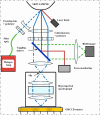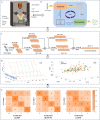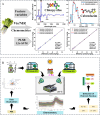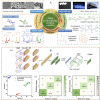Spectroscopic and Imaging Technologies Combined with Machine Learning for Intelligent Perception of Pesticide Residues in Fruits and Vegetables
- PMID: 40807616
- PMCID: PMC12346310
- DOI: 10.3390/foods14152679
Spectroscopic and Imaging Technologies Combined with Machine Learning for Intelligent Perception of Pesticide Residues in Fruits and Vegetables
Abstract
Pesticide residues in fruits and vegetables pose a serious threat to food safety. Traditional detection methods have defects such as complex operation, high cost, and long detection time. Therefore, it is of great significance to develop rapid, non-destructive, and efficient detection technologies and equipment. In recent years, the combination of spectroscopic techniques and imaging technologies with machine learning algorithms has developed rapidly, providing a new attempt to solve this problem. This review focuses on the research progress of the combination of spectroscopic techniques (near-infrared spectroscopy (NIRS), hyperspectral imaging technology (HSI), surface-enhanced Raman scattering (SERS), laser-induced breakdown spectroscopy (LIBS), and imaging techniques (visible light (VIS) imaging, NIRS imaging, HSI technology, terahertz imaging) with machine learning algorithms in the detection of pesticide residues in fruits and vegetables. It also explores the huge challenges faced by the application of spectroscopic and imaging technologies combined with machine learning algorithms in the intelligent perception of pesticide residues in fruits and vegetables: the performance of machine learning models requires further enhancement, the fusion of imaging and spectral data presents technical difficulties, and the commercialization of hardware devices remains underdeveloped. This review has proposed an innovative method that integrates spectral and image data, enhancing the accuracy of pesticide residue detection through the construction of interpretable machine learning algorithms, and providing support for the intelligent sensing and analysis of agricultural and food products.
Keywords: deep learning; imaging; machine learning; pesticide residue; spectral technology.
Conflict of interest statement
Mr. Sheng Cai was employed by the company (Fujian Putian Sea 100 Food Co., Ltd., Putian 351111, China). He participated in Conceptualization, writing-review and editing, supervision in the study. The role of the company was the affiliations of Mr. Cai. The remaining authors declare that the research was conducted in the absence of any commercial or financial relationships that could be construed as a potential conflict of interest.
Figures








Similar articles
-
Short-Term Memory Impairment.2024 Jun 8. In: StatPearls [Internet]. Treasure Island (FL): StatPearls Publishing; 2025 Jan–. 2024 Jun 8. In: StatPearls [Internet]. Treasure Island (FL): StatPearls Publishing; 2025 Jan–. PMID: 31424720 Free Books & Documents.
-
Prescription of Controlled Substances: Benefits and Risks.2025 Jul 6. In: StatPearls [Internet]. Treasure Island (FL): StatPearls Publishing; 2025 Jan–. 2025 Jul 6. In: StatPearls [Internet]. Treasure Island (FL): StatPearls Publishing; 2025 Jan–. PMID: 30726003 Free Books & Documents.
-
Non-destructive spectroscopy-based technologies for meat and meat product discrimination - A review.Meat Sci. 2025 Oct;228:109893. doi: 10.1016/j.meatsci.2025.109893. Epub 2025 Jun 19. Meat Sci. 2025. PMID: 40570613 Review.
-
Management of urinary stones by experts in stone disease (ESD 2025).Arch Ital Urol Androl. 2025 Jun 30;97(2):14085. doi: 10.4081/aiua.2025.14085. Epub 2025 Jun 30. Arch Ital Urol Androl. 2025. PMID: 40583613 Review.
-
Terahertz Spectroscopy for Food Quality Assessment: A Comprehensive Review.Foods. 2025 Jun 23;14(13):2199. doi: 10.3390/foods14132199. Foods. 2025. PMID: 40646950 Free PMC article. Review.
References
-
- Jeyabalan S., Mahesh P., Shanthala M., Devarajan T., Suraj Shashikant D., Ravichandra H., Muniswamy D., Saher I., Akhil S., Supriya M., et al. Mass Spectrometry in Food Analysis. CRC Press; Boca Raton, FL, USA: 2022. Pesticide analysis in food samples by GC-MS, LC-MS, and tandem mass spectrometry; pp. 211–230. - DOI
-
- Yu Y., Chai Y., Yan Y., Li Z., Huang Y., Chen L., Dong H. Near-infrared spectroscopy combined with support vector machine for the identification of Tartary buckwheat (Fagopyrum tataricum (L.) Gaertn) adulteration using wavelength selection algorithms. Food Chem. 2025;463:141548. doi: 10.1016/j.foodchem.2024.141548. - DOI - PubMed
Publication types
LinkOut - more resources
Full Text Sources
Miscellaneous

